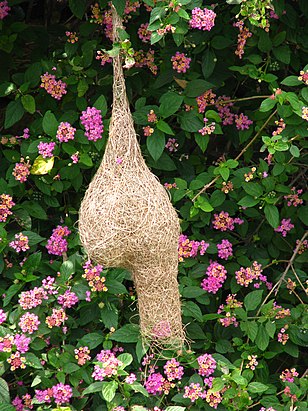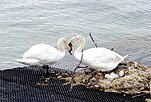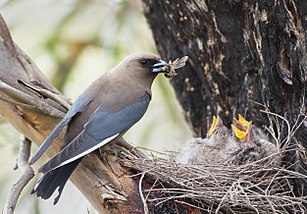Nest
A nest is a structure built for certain animals to hold
Nest building is driven by a biological urge known as the
Nest building
Purposes of nesting
Structural purposes
Nest building (nidification) is often driven by a biological urge in
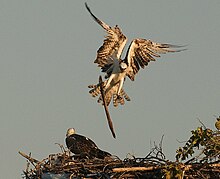
Social purposes
Many nest builders provide parental care to their young, while others simply lay their eggs and leave.
Usage of environment
Versatility in use of construction material may be an adaptive advantage (less energy used to gather materials) or a disadvantage (less ability to specialize construction). The available evidence suggests that natural selection more often favors specialization over flexibility in nest construction.[2][why?]
At the most basic level, there are only two types of nest building: sculpting and assembly.
Sculpting
Sculpting is the process of removing material to achieve the desired outcome. Most commonly this entails burrowing into the ground or plant matter to create a nesting site.
Assembly
Assembly entails gathering, transporting, and arranging materials to create a novel structure. Transportation has the greatest time and energy cost so animals are usually adapted to build with materials available in their immediate environment.
Building materials
Effects on environment
Nest building can have a substantial impact on the environment in which animals live. The combined
Lasting effects
Nests constructed by
Nest builders


Nest architecture may be as useful for distinguishing species as the animals' physical appearance. Species identified through such means are called ethospecies. This is especially common in wasps and termites, but also can apply to birds. In most animals, there is some variation in nest construction between individuals. Whether these differences are driven by genetics or learned behavior is unknown.[2]
With the exception of a few tunneling mammals, nest builders exhibit no specialized anatomy, instead making use of body parts primarily used for other purposes. This is possibly due to the sporadic nature of nest building, minimizing the selective pressures of anatomy used for nest building.[2]
Birds
In general, birds are the most skilled nest builders, although not all species of birds build nests, some laying their
Bird nests vary from simple depressions in the ground known as scrapes to largely unstructured collections of branches to elaborately woven pendants or spheres. The

The sociable weaver builds large communal nests in which many individual nests reside. They divide the nest using walls of grass placed atop a base of large sticks. At the entrances to the nest, sharp sticks are placed to ward off intruders.[4] A single communal site can measure 2 metres (6.6 ft) in height and 8 metres (26 ft) in width. As many as 300 mating pairs may reside in the structure.[5] Other birds often built their own nests on top of Weaver nest sites.[4]
Some birds build nests in
Typical bird nests range from 2 centimetres (0.79 in) in size (
Mammals
Many species of small mammals such as rodents, rabbits, and ground squirrels dig burrows into the ground to protect themselves and their young.[7] Prairie dogs build an elaborate system of tunnels which can span large stretches of land. One such structure, called a town, spanned 25,000 square miles (65,000 km2) and held an estimated 400 million individuals. Their homes are adapted to withstand large (above-ground) temperature variation, floods, and fire. Their young are raised in the deepest chambers where the temperature is the most stable.[4]
Many mammals, including
Gorillas build fresh nests daily out of leaves and other vegetation in which they sleep at night. They sometimes also build nests during the day for resting in. The smaller species of gorilla build their nests in trees, while the larger are confined to the ground. Nests of the western gorilla, the largest species, measure about 1 metre (3.3 ft) in diameter.[8]
Amphibians

Some species of frog build nests ranging from simple to modest complexity.[3] Many stream-dwelling frogs lay their eggs in a gelatinous mass which they attach to underwater vegetation to prevent eggs from washing away.[1] Nests can have other protective qualities. For example, the female Fletcher frog beats secreted mucus into a froth, creating a structure that serves as a line of defense against thermal extremes, predation, and desiccation.
Fish
Fish engage in nest building activities ranging from simply scooping out sediment to building enclosed structures out of plant matter. Male sticklebacks produce a special enzyme in their kidneys that they use to bind plants together.[3]
Reptiles
The American alligator is known for its parenting skills. They build large nests of mud and vegetation on river banks or vegetation mats. The female digs a hole in the center to lay her eggs, covers them, and then guards them for two months until they hatch. When eggs start to hatch, she breaks open the nest which has hardened over time and leads the young to the water where she continues to care for them for another year. Alligators are very particular about their nesting sites and will abandon a site if things go wrong.[1]
Cobras use leaves and other debris to build nests in which they lay eggs that both sexes guard. They carry the vegetation to the nest site by kinking their necks.[3] Sea turtles dig a hole in the sand above the high tide line in which they lay their eggs. They then cover the soft eggs to protect them from the sun and predators and leave.[1]
Dinosaurs
From the fossil record, it is known that many, or perhaps all, dinosaurs laid eggs. Paleontologists have identified a number of features that allow them to distinguish a nesting site from a random clustering of eggs. Those include regular clustering patterns, the co-occurrence of whole eggs with broken eggs and/or hatchlings, and the occurrence of physical features such as evidence of excavation.[1]

The Oviraptor nests of Mongolia are perhaps the most famous case of dinosaur nesting. One specimen was found fossilized atop a nest in a brooding posture, proving the animal had been poorly named (Oviraptor means "egg taker").[1]
A site known as
Insects
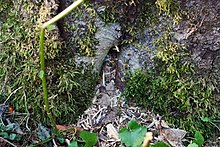
Bees and

Termites build elaborate nests that span multiple generations and may last decades.[2] Using chewed wood, mud, and feces they build large mounds which may extend well into the air.[4] The largest nests, built by members of genus Amitermes, stand nearly 7 metres (23 ft) tall with a similar circumference at the base, and host millions of individuals.[2] Termite mounds are constructed to allow for excellent air flow, regulating the mound temperature. The mounds protect against drying and predation allowing many species to lose ancestral traits such as hard bodies, skin pigmentation, and good eyesight. Magnetic termites construct their nests with flattened sides along the north–south axis to ensure maximum warming during the winter, while exposing minimal surface area to the harshest mid-day sunshine.[2] Other termite species use their nests to farm fungi.[4]
Ant nests feature an elaborate colony structure that may extend 2 metres (6.6 ft) or more underground. As the structure gets further underground, individual chambers become farther and farther apart indicating that the ant is aware of its depth. It is hypothesized that they accomplish this by sensing the level of
Species such as the
The Eastern carpenter bee, Xylocopa virginica, is unique in that individuals of that species build their nests in wood, bamboo culms, agave stalks, and other similar materials, although their preferred nesting material is pine or cedar lumber. When digging the nests, they use the wood shavings scraped from the wall to create partitions within the tunnels. The nests are usually round and have about 1-4 tunnels, each with multiple branches. Because these materials are often useful for humans in construction, X. virgininica's nesting behavior presents the disadvantage of weakening wood in manmade structures.[15]
Effects on other species
The abundance of biological resources within the nest has led to a number of specialized predators. The
Names of nests
- A badger's nest is called a sett.
- A lodge.
- An eagle's nest is called an eyrie.[16]
- An holtor a couch.
- A pheasant's nest is called a nide.[17][vague]
- A rabbit's nest is called a form.[18]
- A squirrel's or ringtail possum's nest is called a drey.
- A wasp's nest is called a vespiary.[19]
See also
- Oology
- Bird's nest soup
- Nest box
- Tree house
References
- ^ a b c d e f g h i j k l m n o Tom Deméré; Bradford D. Hollingsworth (Spring 2002). "Nests and Nest-building Animals" (PDF). San Diego Natural History Museum. Archived (PDF) from the original on 2022-10-09. Retrieved August 19, 2013.
- ^ ISBN 978-0521460385.
- ^ a b c d e f g h i "nest". Encyclopædia Britannica. Archived from the original on September 30, 2013. Retrieved August 19, 2013.
- ^ a b c d e f g h i Mary Beth Griggs (2011-05-26). "8 Amazing Architects of the Animal Kingdom". Popular Mechanics. Archived from the original on August 13, 2013. Retrieved August 22, 2013.
- ^ a b "Most populous bird's nest". Guinness World Records. Archived from the original on August 21, 2014. Retrieved August 20, 2013.
- ^ "Largest bird's nest". Guinness World Records. Retrieved August 20, 2013.
- ^ a b c d "Mammal Nests and Burrows". Kids' Inquiry of Diverse Species. University of Michigan. Archived from the original on December 3, 2013. Retrieved August 20, 2013.
- ^ "Largest mammal to build a nest". Guinness World Records. Retrieved August 20, 2013.
- ISSN 1943-0930.
- ^ Clouse, R. (2001). “Some effects of group size on the output of beginning nests of Mischocyttarus mexicanus (Hymenoptera: Vespidae).” Florida Entomologist. 84(3):418-424.
- ^ "Largest wasp nest". Guinness World Records. Archived from the original on July 2, 2013. Retrieved August 20, 2013.
- ^ S2CID 40390603.
- ^ Jeff Hahn; Colleen Cannon; Mark Ascerno (2008). "Carpenter ants". University of Minnesota. Archived from the original on September 10, 2013. Retrieved August 20, 2013.
- ^ Landi, M., C. Coster-Longman, and S. Turillazzi. "Are the Selfish Herd and the Dilution Effects Important in Promoting Nest Clustering in the Hover Wasp (Stenogastrinae Vespidae Hymenoptera)?" Ethology Ecology & Evolution 14.4 (2002): 297-305. Web.
- ^ Balduf, W. V. (1962-05-01). "Life of the Carpenter Bee, Xylocopa virginica (Linn.) (Xylocopidae, Hymenoptera)". Annals of the Entomological Society of America 55 (3): 263–271. doi:10.1093/aesa/55.3.263. ISSN 0013-8746.
- ^ "eyrie", The Free Dictionary, retrieved 2020-04-21
- ^ "nide", The Free Dictionary, retrieved 2020-04-21
- ISBN 978-0-8368-6699-5
- ^ "vespiary", The Free Dictionary, retrieved 2020-04-21
External links
- Birds as Builders of Homes
- Ingersoll, Ernest (1920). . In Rines, George Edwin (ed.). Encyclopedia Americana.
- Ingersoll, Ernest (1920). . In Rines, George Edwin (ed.). Encyclopedia Americana.

